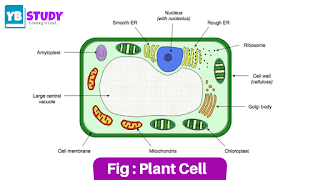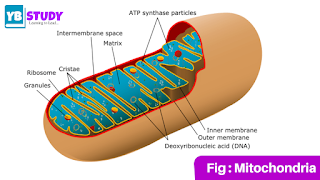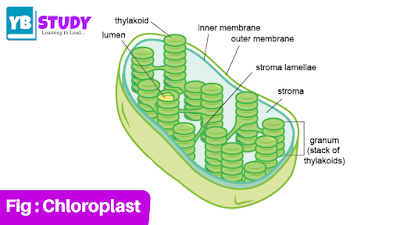Plant Cell : Defination, Structure and Functions, Types
Plant Cell: Definition, Structure and Functions, Types
Definition of plant cell
Plant cells are the basic unit of life of the kingdom Plantae are enclosed by a cell wall, containing a membrane-bound nucleus and other cell organelles, and perform photosynthesis.
What is a Plant Cell?
Plant cells are eukaryotic cells or cells with a membrane-bound nucleus. Unlike prokaryotic cells, the DNA in a plant cell is housed within a nucleus that is enveloped by a membrane.
In addition to having a nucleus, plant cells also contain other membrane-bound organelles (tiny cellular structures) that carry out specific functions necessary for normal cellular operation. Organelles have a wide range of responsibilities that include everything from producing hormones and enzymes to providing energy for a plant cell.
Structure of Plant cell :
1. Cell wall:
- It is a rigid, supportive, and protective outer covering of the plasma membrane of plant cells, fungi, and some protists. Algae show the presence of cellulose, Galatians, mannans, and minerals like calcium carbonate in the cell wall.
- In other plants, it is made up of hemicelluloses, pectin, lipids, and protein.
- Microfibrils of plant cell walls show the presence of cellulose which is responsible for rigidity. Some of the depositions of the cell wall are silica (grass stem), cutin (epidermal walls of land plants), suberin (endodermal cells of the root), wax, and lignin.
- It gives shape to the cell and protects it from mechanical injury and infections. In plants, the cell wall shows the middle lamella, primary wall, and secondary wall.
2. Cell membrane / Plasma membrane/
biomembrane :
- It is a thin, quasi-fluid structure present both extracellularly and intracellularly. Extracellularly, it is present around the protoplast and intracellularly, it is present around most of the cell organelles in a eukaryotic cell. It separates cell organelles from cytosol.
- The thickness of the biomembrane is about 75A°. Under an electron microscope, the cell membrane appears trilaminar (made up of three layers).
- It shows the presence of lipids (mostly phospholipids) arranged in a bilayer. Lipids possess one hydrophilic polar head and two hydrophobic non-polar tails. So, phospholipids are amphipathic.
- Lipid molecules are arranged in two layers (bilayer) in such a way that their tails are sandwiched in between heads.
- Due to this, tails never come in direct contact with aqueous surroundings.
- The cell membrane also shows the presence of proteins and carbohydrates. The ratio of proteins and lipids varies in different cells.
- For example-in human beings, RBCs show approximately 52% protein and 40% lipids.
- Fluid mosaic model: It is the most accepted model of the cell membrane. It was proposed by Singer and Nicholson in 1972.
- According to this model, it is made up of a phospholipid bilayer and proteins. Proteins are like icebergs in the sea of lipids. Proteins can change their position. Some proteins are intrinsic i.e. occur at different depths of the bilayer.
3. Cytoplasm :
- The cell contains a ground substance called cytoplasmic matrix or cytosol. This colloidal jelly-like material is not static.
- It shows streaming movements called cyclosis.
- The cytoplasm contains water as a major component along with organic and inorganic molecules like sugars, amino acids, vitamins, enzymes, nucleotides, minerals, and waste products.
- It also contains various cell organelles like endoplasmic reticulum, Golgi complex, mitochondria, plastids, nucleus, microbodies, and cytoskeletal elements like microtubules.
- Cytoplasm acts as a source of raw materials as well as the seat for various metabolic activities taking place in the cell.
4. Endoplasmic Reticulum (ER):
- This little network within the cytosol is present in all eukaryotic cells except ova and mature red blood corpuscles.
- The membrane of the Endoplasmic reticulum is continuous with the nuclear envelope at one end and extends to the cell membrane.
- It thus acts as an intracellular supporting framework and helps in maintaining the position of various cell organelles in the cytoplasm.
- The outer surface of the endoplasmic reticular membrane may or may not be studded with ribosomes. Accordingly, it is called rough or smooth ER.
- Smooth and rough ER differ in their functions.
- Smooth ER is involved in various processes in different cells. Depending on cell type, it helps in the synthesis of lipids (ex. steroid secreting cells of the cortical region of the adrenal gland, testes, and ovaries), detoxification of drugs, and poisons (liver ce, cells), and storage of calcium ions (muscle cells).
- Rough ER is primarily involved in protein synthesis. (e.g. pancreatic cells that secrete insulin). These proteins are secreted by ribosomes attached to rough ER and are called secretory proteins. These proteins get wrapped in a membrane that buds off from the transitional region of ER. Such membrane-bound proteins depart from ER as transport vesicles.
5. Golgi complex :
- Golgi complex or Golgi apparatus or Golgi body; various terms are used to denote this assembly, manufacturing cum packaging, and transport unit of the cell.
- The Golgi complex essentially consists of stacks of membranous sacs called cisternae.
- The diameter of cisternae varies from 0.5 to 1 µm. A cell may have a few to several cisternae depending on its function.
- The Golgi sacs show specific orientation in the cell. Each cisterna has a forming or ‘cis’ face (cis: on the same side) and maturing or ‘ trans’ face (trans: the opposite side).
- Transport vesicles that pinch off from transitional ER merge with the cis face of Golgi cisterna and add its contents into the lumen.
- The Golgi body carries out two types of functions, modification of secretions of ER and production of its secretions.
- Cisternae contain specific enzymes for specific functions. The refining of the product takes place in an orderly manner.
- Golgi bodies also manufacture their products. Golgi bodies in many plant cells produce non-cellulose polysaccharides like pectin.
6. Lysosomes :
- Lysosomes can be considered as dismantling and restructuring units of a cell.
- These are membrane-bound vesicles containing hydrolytic enzymes. The enzymes in lysosomes are used by most eukaryotic cells to digest (hydrolyze) macromolecules. The lysosomal enzymes show optimal activity in acidic pH.
- Lysosomes are polymorphic.
- We can classify lysosomes as, Primary lysosomes; which are nothing but membrane-bound vesicles in which enzymes are in an inactive state.
- Secondary lysosomes or hybrid lysosomes, which are formed by the fusion of lysosomes with endocytic vesicle-containing materials to be digested, are represented as heterophonic vesicles.
- Lysosomes which bring about digestion of the cell’s organic material like a damaged cell organelle, are called autophagic vesicles (or suicide bags).
7. Vacuoles :
- Vacuoles are membrane-bound sacs prominently found in plant cells. In animal cells, whenever present they are few in number and smaller in size. Generally, there are two or three permanent vacuoles in a plant cell.
- Vacuoles can occupy as much as 90% of the total volume of the cell.
- The vacuoles are bound by a semipermeable membrane, called the tonoplast membrane.
- This membrane helps in maintaining the composition of vacuolar fluid; the cell sap, different from that of the cytosol.
- Intake of food or foreign particle by phagocytosis involves the formation of a food vacuole. In freshwater unicellular forms like Paramoecium, excretion, and osmoregulation take place by contractile vacuoles.
- Vacuoles maintain the turgidity of the cell.
9. Mitochondria:
- These are important cell organelles involved in aerobic respiration.
- Mitochondria are absent in prokaryotic cells and red blood corpuscles (RBCs). Their shape may be oval or spherical or spiral strip-like.
- It is a double membrane-bound organelle. The outer membrane is permeable to various metabolites due to the presence of a protein -Porin or Parson’s particles.
- The inner membrane is selectively permeable to a few substances only.
- Both membranes are separated by a space-outer chamber.
- The inner membrane shows several finger-like or plate-like folds- cristae.
- The inner membrane bears numerous particles- exosomes, and cytochromes/electron carriers.
- The inner membrane encloses a cavity- an inner chamber, containing a fluid- matrix. The matrix contains a few coils of circular DNA, RNA, 70S types of ribosomes, lipids, and various enzymes of the Krebs cycle and other pathways.
10. Plastids :
- Like mitochondria, plastids too are double-walled organelles containing DNA, RNA, and 70S ribosomes. But they are larger and can be observed under a light microscope.
- Plastids are classified according to the pigments present in them as leucoplasts, chromoplasts, and chloroplasts.
- Leucoplasts do not contain any pigments, they are of various shapes and sizes. These are meant for the storage of nutrients. e.g. Amyloplasts that store starch, Elaioplasts that store oils, and Aleuroplasts that store proteins.
- Chromoplasts contain pigments like carotene and xanthophyll, etc. They impart red, yellow, or orange color to flowers and fruits.
- Plant cells, cells of algae, and a few protists like Euglena contain chloroplasts. The inner membrane of double-walled chlorophyll is comparatively less permeable.
- Inside the cavity of the inner membrane, there is another set of membranous sacs called thylakoids.
- Thylakoids are arranged in the form of stacks called grana (singular: granum).
- The grana are connected using membranous tubules called stroma lamellae. Space outside thylakoids is filled with stroma.
- The stroma and the space inside thylakoids contain various enzymes essential for photosynthesis. Like other plastids, the stroma of chloroplast also contains DNA and ribosomes.
11. Ribosomes :
- You are aware that ribosomes are protein factories of the cell. They use genetic information to synthesize proteins.
- Ribosomes were first observed as dense particles in the electron micrograph of a cell by scientist Pallade in 1953.
- Ribosomes are made up of Ribosomal RNA and proteins. They do not have any membranous covering around them.
12. Nucleus :
- The structure of the nucleus of a plant cell becomes distinct in a non-dividing cell or during interphase. Such an interphase nucleus is made up of a nuclear envelope, nucleoplasm, nucleolus, and chromatin network.
- A nuclear envelope is a double-walled delimiting membrane of the nucleus.
- Two membranes are separated from each other by perinuclear space (10 to 50nm). The outer membrane is connected with the endoplasmic reticulum at places.
- The nucleoplasm or karyolymph contains various substances like nucleic acids, protein molecules, minerals, and salts.
- It contains a chromatin network and nucleolus.
- The nucleolus is another component that is not bound by a cell membrane.
- The nucleolus is made up of rRNA and ribosomal proteins and it is best known as the site of ribosome biogenesis.
- They appear as dense spherical bodies present near the chromatin network. They produce rRNA and ribosomal proteins which are then transported to the cytoplasm and are assembled to form ribosomes.
Chromatin material :
- The nucleus contains genetic information in the form of chromosomes which are nothing but DNA molecules associated with proteins.
- The chromatin material contains DNA, histone and non-histone proteins, and RNA.
- In some regions of chromatin, DNA is more and is genetically active called euchromatin. Some regions that contain more proteins and less DNA and are genetically inert are called heterochromatin
The nucleus contains entire genetic information and hence plays an important role in heredity and variation. It is the site for the synthesis of DNA, RNA, and ribosomes. It plays an important role in protein synthesis. Chromosome number being constant for a species, it is important in phylogenetic studies. The nucleus thus is the master cell organelle.
Functions of plant cell
- As the basic living part of a plant, the plant cell is involved in many physiological and structural activities.
- They range from the synthesis of proteins and energy to maintaining structural integrity and tautness.
- Various organelles (sub-cell parts) within the plant cell are dedicated to specific tasks.
- the cell wall provides support for the internal parts and protects them from external forces.
- The chloroplast is involved in photosynthesis.
- The mitochondria specialize in energy synthesis within the cell.
- The endoplasmic reticulum is used in the synthesis of ions and proteins, packaging them, and storing them.
- The cell nucleus is the control center from which all the various cellular activities are coordinated.
Frequently Asked Questions
Who discovered the plant cell?
Answer: Robert Hooke, The cell was first discovered and named by Robert Hooke in 1665. He remarked that it looked strangely similar to cellular or small rooms which monks inhabited, thus deriving the name. However, what Hooke saw was the dead cell walls of plant cells (cork) as they appeared under the microscope.
2. Which is the largest plant cell
Answer: Xylem, the vascular tissue in plants that conducts water and nutrients, is the largest plant cell. Xylem elements are many millimeters (mm) long and have a narrow lumen. Ovules of cycas are the largest plant cell in multicellular plants. Unicellular marine algae, acetabular.
3. What is the function of the cell wall in a plant cell?
Answer: The cell wall is a protective layer outside the cell membrane that also provides support for the cell’s structure.
- The cell wall provides a definite shape and support to the cell.
- It acts as a gatekeeper, which allows the entry and exit of only certain substances. The cell wall, is thus, selectively permeable.
- It protects the cell from over-expansion.
- The cell wall protects the plant from insects and pathogens.
- It prevents the loss of water.
4. What are the organelles present in plant cells and their functions
Answer: Plant cells carry different organelles depending upon the type of cell considered. The most commonly presented organelles are as follows.
- Cell membrane: the barrier between cell protoplast and external environment.
- Cell wall: A structure responsible for plant strength and support.
- Cytoplasm: The liquid medium inside a cell.
- Cytoskeleton: The set of microtubules microfilaments and intermediate filaments which give a cell its shape.
- Central vacuole : stores water for turgidity.
- Nucleus: contains the genetic code of the cell and is responsible for its functions.
- Ribosome: Protein synthesis.
- Golgi apparatus: packing and finishing of cell products. Addition of carbohydrates to proteins and lipids to form glycoproteins and glycolipids.
- Endoplasmic reticulum: transport channels within a cell for cell products.
- Mitochondria: cell powerhouse.
- Peroxisomes: formation and decomposition of hydrogen peroxide.
- Plasmodesmata: channels between cells for the transport of molecules.
- Chloroplasts: present in leaves for photosynthesis.
- Chromoplasts: present in petals or fruit skin for giving colors to the parts.
- Leucoplasts: found in underground parts of plants to store food.
- Glyoxysomes: present in plant seedlings for converting stored fatty acid to carbohydrates.
Is plant cells living or dead?
Answer: Plant has both living and dead cells. Simple tissue such as parenchyma and collenchyma is living but sclerenchyma is dead, whereas in complex tissues the xylem tracheids, vessels, and fibers are dead but xylem parenchyma is living while phloem fibers are dead but phloem parenchyma, companion cells, sieve tube elements of phloem are living.
What are the different types of plant cells?
Answer: There are various types of plant cells which include: parenchyma cells, sclerenchyma cells, collenchyma cells, xylem cells, and phloem cells.
Why does a plant cell have large vacuoles?
Answer: Vacuoles also play an important role in plant cell Structure. Plant cells contain large vacuoles To store food and water And To hold turgor pressure across the cell wall.
What is the powerhouse of a plant cell?
Answer: Mitochondria are the powerhouse of the plant cell. These structures are nicknamed the powerhouse of the cell because they work to convert energy into forms that the cell can use.
What is the function of plasmodesmata in a plant cell?
Answer: Plasmodesmata transport water minerals and whatnot (which could be said to be large molecules)). The most important function of plasmodesmata is to connect cells to facilitate water transport. Plasmodesmata are cytoplasmic bridges through the cell wall connecting the cytoplasm of adjacent plant cells. The cell membrane lines the pores and therefore does not separate the adjacent cells.
Which organelle is only found in a plant cell?
Answer :
- All plants cells have a cellulose cell wall
- All plants cells are separated by a cell plate which later differentiates to form plasmodesmata
- All plants cells have fluid-filled sap vacuole
- Many plants cells have plastids



